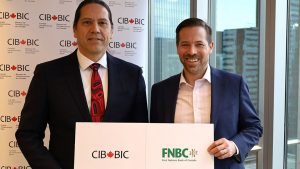Just two months after a federal election campaign in which the Canada Infrastructure Bank was on the chopping block, two CIB executives spoke with swagger at a recent P3 conference as they outlined 19 new projects taken on in the last year.
The two main opposition parties promised to scrap the CIB if they won the federal election in September but with the governing Liberals now back in power, CIB CEO Ehren Cory and chairperson Tamara Vrooman explained to delegates attending the virtual CCPPP conference Nov. 18 how the CIB’s role has been refined in the past year with a growing list of projects aligned with five government priorities.
“They set the outcomes and then they give us the authority to do deals,” Cory said of the CIB’s alignment with the government. “I wouldn’t say that’s a new direction, but I would say it’s a really clarified one. It’s what’s allowed us to accelerate our momentum.”
The CIB was created by the federal government in 2017 with a mandate to invest $35 billion in revenue-generating infrastructure projects, leveraging private investment to support projects that reflect government priorities.
As of a year ago the CIB had only Montreal’s REM transit line in its files but it got fresh traction last fall when the Ministry of Infrastructure and Communities handed it a $10 billion Growth Plan with instructions to invest in retrofits, broadband, clean-energy transmission, agriculture irrigation, and zero-emission buses and charging infrastructure.
A year later, Cory and Vrooman were able to point to a total of $6.3 billion in CIB investment commitments, $5 billion of which has been approved in the last year, serving as a catalyst for projects with an estimated total capital cost of $17.8 billion.
The investments break down into transit, $2.6 billion; clean power, $1.4 billion; green infrastructure, $300,000; broadband, $1.5 billion; and trade and transportation, $500,000.
The day after the conference, the CIB announced a 21st project, a plan to spend $400 million on zero-emission school buses in Quebec.
Cory joined the CIB in October 2021.
“With Ehren’s leadership, we’re really pleased at the amount of deals we’ve put through over the last seven or eight months,” said Vrooman.
“What we’re seeing at the infrastructure bank really coast to coast is a focus on getting more projects done across a variety of sectors that really are going to lay the foundation for the future economy and society that we need in this country.”
Cory also announced the imminent launch of a new tool to address marketplace information needs, a Market Update and Investment Outlook modelled in part on the Market Update regularly published by his previous employer, Infrastructure Ontario (IO).
Cory said the new document, to be released later that day, would not have the same function as IO’s Market Update, because the CIB does not have a pipeline of projects for investors or contractors to bid on but rather puts together deals on an ad hoc basis.
Cory said, “Rather than think of it as a pipeline of things someone could bid on, think of it as a call from us for good ideas for investment proposals and for opportunities.”
The recently announced $1.4-billion partnership between the CIB and Enwave Energy Corporation to accelerate and upsize district energy projects in Toronto and Mississauga is a good example of the way the CIB can work with private partners to upgrade existing projects, Cory said. The CIB is allocating $600 million to the project.
“We went to them and said, ‘what if together we oversize that project, we build it bigger than it might have otherwise been.’ We can provide patient long-term capital to allow that to happen,” said Cory.
Panel moderator Lisa Raitt asked Cory to explain the “churn” at the bank since it was created, with three chairs, two CEOs and several ministers.
“That’s a very fair question. I think the answer is we’ve gotten much clearer and sharper over the last three-and-a-half years,” Cory said. “Nothing’s changed in the mandate, but we’ve got much sharper on how to deliver on that mandate.”
The five mandates assigned by the government are building an economy that reduces its use of GHG emissions and moves Canada towards net-zero while making Canada competitive globally; better transit; better connectivity through broadband; improving trade capacity; and supporting Indigenous communities.
“It took us a bit of time to find the best path forward between the government and CIB, to be able to execute at pace,” said Vrooman. “We’ve now found that cadence.”








Recent Comments
comments for this post are closed